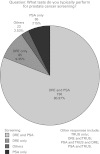Prostate cancer screening: Attitudes and practices of family physicians in Ontario
- PMID: 22664631
- PMCID: PMC3367015
- DOI: 10.5489/cuaj.11290
Prostate cancer screening: Attitudes and practices of family physicians in Ontario
Abstract
Introduction: : The utility of prostate cancer screening is controversial. We sought to determine whether Ontario's family physicians believe it is beneficial and to characterize their screening protocols.
Methods: : A survey was developed with input from urologists, family physicians and the Ontario Medical Association's Section on General and Family Practice. Questions covered three domains: (1) demographics, (2) beliefs about screening utility and (3) screening practices. All 7302 family physicians in Ontario were invited by email to complete the online survey.
Results: : A total of 969 physicians completed the survey; 955 (52.0% male, 48.0% female) were included. Most (80.97%) use prostate-specific antigen (PSA) and digital rectal examination (DRE) for screening; 9.4% use DRE alone and 7.15% PSA. Of the respondents, 8.3% do not offer prostate cancer screening. Most physicians begin offering screening at age 50 (72.9%) and stop at ages 70 or 80 (68.4%); 17.9% offer lifelong screening. In response to the statement "screening with DRE provides a survival benefit," 37.6% and 32.6 agreed and disagreed, respectively. For "screening with PSA provides a survival benefit," 43.3% agreed and 31.0% disagreed. For the statement "the benefits of prostate cancer screening outweigh the risks," 51.4% agreed and 22.0% disagreed.
Discussion: : Although 91.7% of respondents offer prostate cancer screening, they are divided over its utility. Only 51.4% were convinced that the benefits outweighed the harms. There is significant variability between physicians' screening protocols. A limitation of this study is the possibility of selection bias. Nevertheless, this is the largest sample of Ontario family physicians ever surveyed about prostate cancer screening and highlights divergent physician practices and a need for more conclusive evidence on screening utility.
Figures




Comment in
-
The confusion surrounding prostate cancer screening faced by family physicians.Can Urol Assoc J. 2012 Jun;6(3):194-5. doi: 10.5489/cuaj.12123. Can Urol Assoc J. 2012. PMID: 22664632 Free PMC article. No abstract available.
References
-
- Canadian Cancer Society’s Steering Committee on Cancer Statistics. Canadian Cancer Statistics 2011. Toronto, ON: Canadian Cancer Society; 2011.
-
- Ries LA, Melbert D, Krapcho M, et al. National Cancer Institute; SEER Cancer Statistics Review, 1975–2005. Available: http://seer.cancer.gov/csr/1975_2005/ (Accessed May 2, 2012).
-
- Gibbons L, Waters C. Prostate cancer: testing, incidence, surgery and mortality. Health Rep. 2003;14:9–20. - PubMed
LinkOut - more resources
Full Text Sources
Research Materials
Miscellaneous
